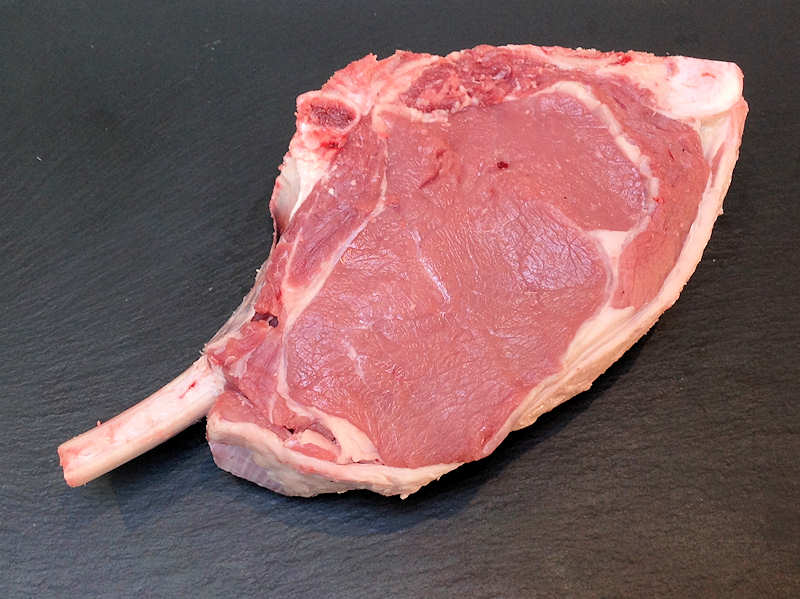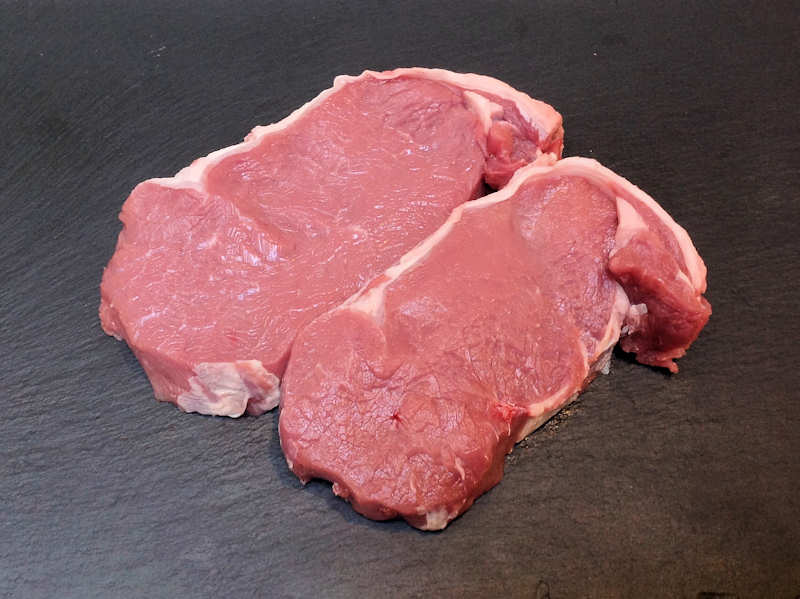Rose Veal is welfare friendly veal with the calves reared in open straw yards and allowed access to roughage to eat. This gives the meat a pinker colour than the intensively reared continental veal. We have a selection of cuts available including joints, osso bucco and escallops.
 |
 |
 |
| diced veal | veal escalope | veal topside |
 |
 |
 |
| rose veal wing rib |
rose veal trim steak | rose veal sirloin steaks |
 |
||
| rose veal sirloin roast |
Rose veal history.
Veal is the meat of young cattle (calves), in contrast to the beef from older cattle. Though veal can be produced from a calf of either sex and any breed, most veal comes from male calves (bull calves) of dairy cattle breeds.Generally, veal is more expensive than beef from older cattle.
Free-raised veal.
There are several types of veal with terminology varying by country.
Bob veal, from calves that are slaughtered when only a few days old (at most 1 month old) up to 60 lb.
Formula-fed ("white" or "milk-fed") veal, from calves that are raised on a milk formula supplement. The meat colour is ivory or creamy pink, with a firm, fine, and velvety appearance. They are usually slaughtered when they reach 18–20 weeks of age, 450 to 500 pounds (200 to 230 kg).
Non-formula-fed ("red" or "grain-fed") veal,from calves that are raised on grain, hay, or other solid food, in addition to milk. The meat is darker in colour, and some additional marbling and fat may be apparent. It is usually marketed as calf, rather than veal, at 22–26 weeks of age, 650 to 700 pounds (290 to 320 kg).
Rose veal in the UK (generally called young beef in Europe), is from calves raised on farms in association with the UK Royal Society for the Prevention of Cruelty to Animals' Freedom Food programme. Its name comes from its pink colour, which is a result of the calves being slaughtered at or after 35 weeks (8 months up to 12 months)
Pasture-raised veal.
Free-raised veal is from calves are raised in the pasture with unlimited access to mother's milk and pasture grasses. They are not administered hormones or antibiotics. These conditions replicate those of pasture-raised veal. The meat is a rich pink color. Free-raised veal is typically lower in fat than other veal.Calves are slaughtered at about 24 weeks of age.
Special-fed veal is from calves fed a balanced milk or soy based diet one fortified with 40 essential nutrients, including essential amino acids, carbohydrates, fats, dietary iron and other dietary minerals and vitamins. As of 2013, the majority of veal calves in the USA are special-fed.
Boneless veal cutlets.
Minced veal with garlic and shiitake on pasta.
Veal has been an important ingredient in Italian and French cuisine from ancient times. The veal is often in the form of cutlets, such as the Italian cotoletta or the famous Austrian dish Wiener Schnitzel. Some classic French veal dishes include fried escalopes, fried veal grenadines (small, thick fillet steaks), stuffed paupiettes, roast joints, and blanquettes. Because veal is lower in fat than many meats, care must be taken in preparation to ensure that it does not become tough. Veal is often coated in preparation for frying or eaten with a sauce. Veal Parmigiana is a common Italian-American dish made with breaded veal cutlets.
In addition to providing meat, the bones of calves are used to make a stock that forms the base for sauces and soups such as demi-glace. Calf stomachs are also used to produce rennet, used in the production of cheese. Calf offal is also widely regarded as the most prized animal offal.Most valued are the liver, sweetbreads, kidney, and bone marrow. The head, brains, tongue, feet, and mesentery are also valued.
At birth.
Newborn calves are given a varied amount of time with their mothers, which can be anything from a few hours to a few days.Free-raised calves are raised alongside their mothers, and always have access to their mothers' milk.
The modern veal industry has strong connections with the dairy industry.[8][9] To produce milk, cows must be lactating, and to be lactating, they must get pregnant and give birth. Since only female calves are used to produce milk, use of male dairy calves is limited, outside of breeding.
The veal industry's integration with the dairy industry goes beyond the purchase of surplus calves. It also buys large amounts of milk byproducts. Almost 70% of veal feeds (by weight) are milk products. Most popular are whey and whey protein concentrate (WPC), byproducts of the manufacture of cheese. Milk byproducts are sources of protein and lactose. Skimmed milk powder, casein, buttermilk powder and other forms of milk byproducts are used from time to time.
Housing.
Three different primary types of housing used for veal calves: hutches, stalls or various types of group housing.
Feeding.
"Milk-fed" veal calves consume a diet consisting of milk replacer, formulated with mostly milk-based proteins and added vitamins and minerals. This type of diet relates to infant formula and is also one of the most common diets used for calves in the veal industry.
"Grain-fed" calves normally consume a diet of milk replacer for the first six to eight weeks. The calves then move on to a mostly corn-based diet.
Free-raised calves are raised on an open pasture and receive a diet of milk, grass, and fresh water. Furthermore, free-raised calves do not receive antibiotics, which is often a focus of criticism amongst animal welfare organizations.
Animal welfare.
Veal is a controversial issue in terms of animal welfare.
Multiple animal welfare organizations, who strongly focus on factory farming, attempt to educate consumers about several veal production procedures they consider to be inhumane. This education has proven successful in creating pressure on the industry, resulting in changes in the methods used by the veal industry.
Living space is a commonly raised issue of veal farming.
A strong animal welfare movement concerning veal started in the 1980s with the release of photographs of veal calves tethered in crates where they could barely move. After the release of these photographs, veal sales have plummeted, and have never recovered.
Many veal farmers have started improving conditions in their veal farms. The American Veal Association has announced their plan to phase out the use of crates by 2017, which is often the main focus of controversy in veal farming.
Criticism of veal crates revolves around the fact that the veal calves are highly restricted in movement; have unsuitable flooring; spend their entire lives indoors; experience prolonged sensory, social, and exploratory deprivation; and are more susceptible to high amounts of stress and disease. According to the Veal Quality Assurance Program, the Veal Issues Management Program industry fact sheet, and the Ontario Veal Association, individual housing systems are important for disease control and in reducing the possibility of physical injury. Furthermore, they state it also allows for veal farmers to provide more personal attention to veal calves.
Alternative agricultural practices for using male dairy calves include raising bob veal (slaughter at two or three days old), raising calves as "red veal" without the severity of dietary restrictions needed to create pale meat (resulting in fewer antibiotic treatments and lower calf mortality),and as dairy beef.
In 2008-2009 the demand for free-raised veal rose rapidly.
Drug usage.
The USDA does not approve the use of hormones on veal calves for any reason, with the exclusion for use in ruminating cattle, which is not related to veal.They do, however, approve the use of antibiotics in veal raising to treat or prevent disease. There are no checks to see whether farmers and veal producers do not use antibiotics for reasons other than preventing or treating diseases.
In 2004, the United States Department of Agriculture (USDA) expressed concern that the use of illegal drugs might be widespread in the veal industry.In 2004, an official of the USDA found a lump on a veal calf in a Wisconsin veal farm, which turned out to be an illegal hormone implant (such implants are only allowed legally for beef cattle). PETA suggests this practice has been going on for 30 years.In 2004 the organisation stated "Penicillin is not used in calf raising: tetracycline has been approved, but is not widely used.
Crate bans.
The following shows where veal crates have been banned or are currently in the process of being banned.
Europe
Veal crates became illegal in the UK in 1999 and a full ban has been placed for the entire European Union, as of 2007.
Veal calf production as such is not allowed in many Northern European countries, such as in Finland. In Finland, giving feed, drink or other nutrition which is known to be dangerous to an animal which is being cared for is prohibited, as well as failing to give nutrients the lack of which is known to cause the animal to fall ill. The Finnish Animal Welfare Act of 1996 and the Finnish animal welfare decree of 1996 effectively banned crates in Finland and provided general guidelines for the housing and care of animals.
Veal crates are not specifically banned in Switzerland, but most calves are raised outdoors.
United States.
This section is outdated. Please update this article to reflect recent events or newly available information. (August 2013)
As of 2009, six states ban the use of veal crates in the United States. Nationally, several large veal producers and the American Veal Association are also working to phase out the industry use of veal crates. State-by-state veal crate bans are as follows:
Arizona (since 2012, a part of Proposition 204)
Colorado (since 2012)
California (effective 2015, a part of Proposition 2)
Maine (since 2011)
Michigan (effective 2013)
Rhode Island (since July 2013)






